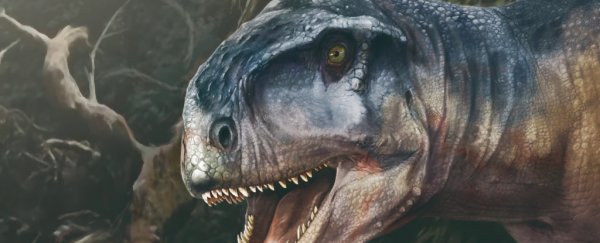A dig in Argentina has unearthed a previously undiscovered species of dinosaur, and the tyrannosaur-like predator has been given a name to suit what we know about it so far: Llukalkan aliocranianus, or 'one who causes fear'.
Able to grow as long as an elephant, and with sharp teeth and a powerful bite, L. aliocranianus would undoubtedly have been a fearsome sight for any other creature that happened across it during the Late Cretaceous period, which leads up to the extinction of the dinosaurs 66 million years ago.
The new species is an abelisaurid, though one that probably had better hearing (similar to a modern-day crocodile) than the other nine species in the family found so far. The dinosaur also had huge claws in its feet, and a keen sense of smell, researchers say.
 Artist's impression of Llukalkan aliocranianus. (Jorge Blanco and Journal of Vertebrate Paleontology)
Artist's impression of Llukalkan aliocranianus. (Jorge Blanco and Journal of Vertebrate Paleontology)
"This is a particularly important discovery because it suggests that the diversity and abundance of abelisaurids were remarkable, not only across Patagonia, but also in more local areas during the dinosaurs' twilight period," says paleontologist Federico Gianechini, from the National University of San Luis in Argentina.
Patagonia and other areas of the ancient supercontinent Gondwana – now split apart into Africa, India, Antarctica, Australia, and South America – were where the abelisaurids roamed.
While their short forearms gave them a similar look to the T. rex, they had unusually short and deep skulls, often bearing crests, bumps, and horns. This particular dino would have had bulges on its head similar to the Gila monster lizard.
The researchers have determined that L. aliocranianus shared the same part of the world at the same time as another abelisaurid, Viavenator exxoni, though the new species would have been smaller.
"These dinosaurs were still trying out new evolutionary pathways and rapidly diversifying right before they died out completely," says paleontologist Ariel Mendez, from the Patagonian Institute of Geology and Paleontology in Argentina.
 Skull of Llukalkan aliocranianus. (Journal of Vertebrate Paleontology)
Skull of Llukalkan aliocranianus. (Journal of Vertebrate Paleontology)
Part of the fossilized remains of the 'one who causes fear' include a braincase, showing a feature unique among abelisaurids: a small posterior air-filled sinus in the middle ear zone, which helped with that croc-like hearing.
That hearing may well have improved the dinosaur's abilities as a predator, and the research team says that both L. aliocranianus and V. exxoni would have been among the most dangerous meat-eaters of the time.
 Map and images showing where the specimen was found in Argentina. (Gianechini et al., Journal of Vertebrate Paleontology, 2021)
Map and images showing where the specimen was found in Argentina. (Gianechini et al., Journal of Vertebrate Paleontology, 2021)
It's likely that there's more to find in the region too, from around 80 million years ago – a period that seems to have been a prosperous one for the abelisaurids and the furileusaurs ('stiff-backed lizards') that made up this part of the family.
"This discovery also suggests that there are likely more abelisaurids out there that we just haven't found yet, so we will be looking for other new species and a better understanding of the relationship among furilesaurs," says Gianechini.
The research has been published in the Journal of Vertebrate Paleontology.
